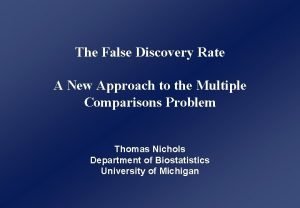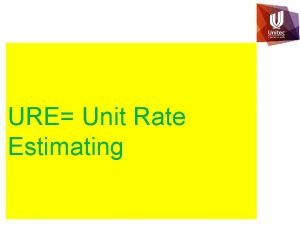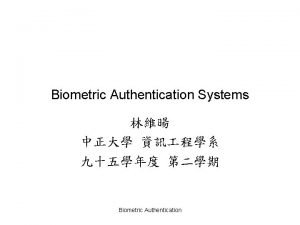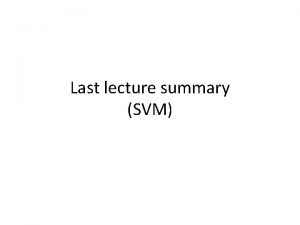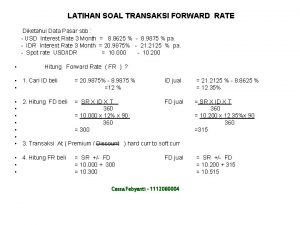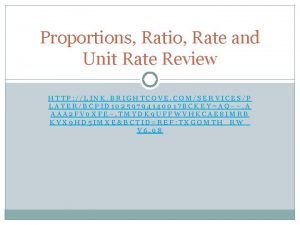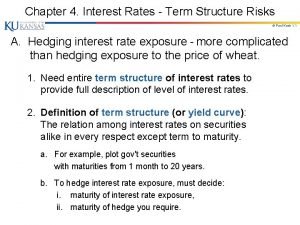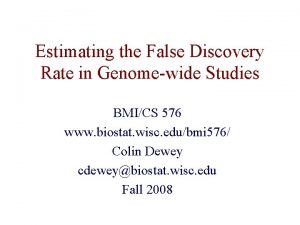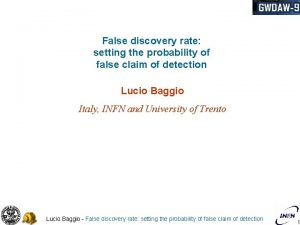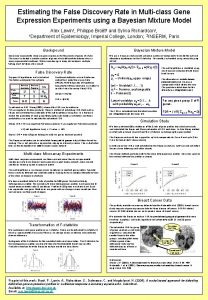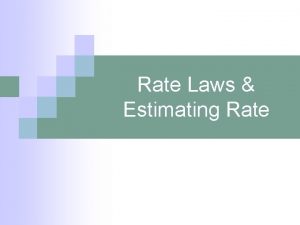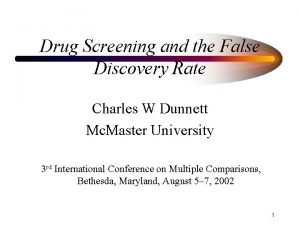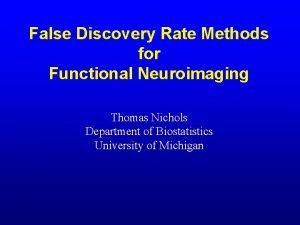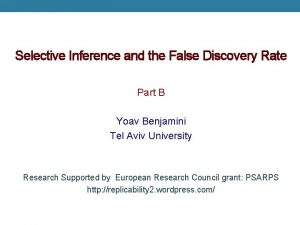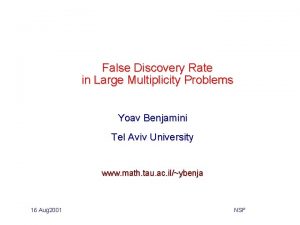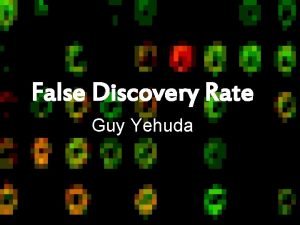Estimating the False Discovery Rate in Genomewide Studies








![The False Discovery Rate [Benjamini & Hochberg ‘ 95; Storey & Tibshirani ‘ 02] The False Discovery Rate [Benjamini & Hochberg ‘ 95; Storey & Tibshirani ‘ 02]](https://slidetodoc.com/presentation_image/1f63bafb7afb5653dcfc7f9bf8777c8a/image-9.jpg)






- Slides: 15

Estimating the False Discovery Rate in Genome-wide Studies BMI/CS 576 www. biostat. wisc. edu/bmi 576/ Colin Dewey cdewey@biostat. wisc. edu Fall 2008

Expression in BRCA 1 and BRCA 2 Mutation-Positive Tumors Hedenfalk et al. , New England Journal of Medicine 344: 539 -548, 2001. • 7 patients with BRCA 1 mutation-positive tumors vs. patients with BRCA 2 mutation-positive tumors • 5631 genes assayed 7

Expression in BRCA 1 and BRCA 2 Mutation-Positive Tumors • Key question: which genes are differentially expressed in these two sets of tumors? • Methodology: for each gene, use a statistical test to assess the hypothesis that the expression levels differ in the two sets

Hypothesis Testing • consider two competing hypotheses for a given gene: – null hypothesis: the expression levels in the first set come from the same distribution as the levels in the second set – alternative hypothesis: they come from different distributions • we first calculate a test statistic for these measurements, and then determine its p-value • p-value: the probability of observing a test statistic that is as extreme or more extreme than the one we have, assuming the null hypothesis is true

Calculating a p-value 1. calculate test statistic T statistic) (e. g. 2. see how much mass in null distribution with value this extreme or more where if test statistic is here, p = 0. 034

The Multiple Testing Problem • if we’re testing one gene, the p-value is a useful measure of whether the variation of the gene’s expression across two groups is significant • suppose that most genes are not differentially expressed (this is the typical situation) • if we’re testing 5000 genes that don’t have a significant change in their expression (i. e. the null hypothesis holds), we’d still expect about 250 of them to have p-values ≤ 0. 05 • Can think of p-value as the false positive rate over null genes

Family-wise error rate • One way to deal with the multiple testing problem is to control the probability of rejecting at least one null hypothesis when all genes are null • This is the family-wise error rate (FWER) • Simplest approach (Bonferroni correction) – Set threshold for calling a p-value significant to α/g, where g is the number of genes – Then FWER is ≤ α

Loss of power with FWER • FWER, and Bonferroni in particular, reduce our power to reject null hypotheses – As g gets large, p-value threshold gets very small • For expression analysis, FWER and false positive rate are not really the primary concern – We can live with false positives – We just don’t want too many of them relative to the total number of genes called significant
![The False Discovery Rate Benjamini Hochberg 95 Storey Tibshirani 02 The False Discovery Rate [Benjamini & Hochberg ‘ 95; Storey & Tibshirani ‘ 02]](https://slidetodoc.com/presentation_image/1f63bafb7afb5653dcfc7f9bf8777c8a/image-9.jpg)
The False Discovery Rate [Benjamini & Hochberg ‘ 95; Storey & Tibshirani ‘ 02] gene p-value rank C F G J I B A D H E 0. 0001 0. 016 0. 019 0. 030 0. 052 0. 10 0. 35 0. 51 0. 70 1 2 3 4 5 6 7 8 9 10 • suppose we pick a threshold, and call genes above this threshold “significant” • the false discovery rate is the expected fraction of these that are mistakenly called significant (i. e. are truly null)

The False Discovery Rate gene p-value rank C F G J I B A D H E 0. 0001 0. 016 0. 019 0. 030 0. 052 0. 10 0. 35 0. 51 0. 70 1 2 3 4 5 6 7 8 9 10 # genes t

The False Discovery Rate • to compute the FDR for a threshold t, we need to estimate E[ F(t) ]and E[ S(t) ] estimate by the observed S(t) • so how can we estimate E[ F(t) ]?

What Fraction of the Genes are Truly Null? • consider the histogram of p-values from Hedenfalk et al. – includes both null and alternative genes – but we expect null p-values to be uniformly distributed estimated proportion of null p-values Figure from Storey & Tibshirani PNAS 100(16), 2002.

The False Discovery Rate estimated proportion of null p-values gene p-value rank q-value C F G J I B A D H E 0. 0001 0. 016 0. 019 0. 030 0. 052 0. 10 0. 35 0. 51 0. 70 1 2 3 4 5 6 7 8 9 10 0. 001 0. 005 0. 053 0. 0475 0. 060 0. 08 0. 14 0. 44 0. 57 0. 70 t # genes

q-values vs. p-values for Hedenfalk et al. Figure from Storey & Tibshirani PNAS 100(16), 2002.

FDR Summary • in many high-throughput experiments, we want to know what is different across a two sets of conditions/individuals (e. g. which genes are differentially expressed) • because of the multiple testing problem, p-values may not be so informative in such cases • the FDR, however, tells us which fraction of significant features are likely to be null • q-values based on the FDR can be readily computed from p -values (see Storey’s package QVALUE)
 False discovery rate calculator
False discovery rate calculator Unit rate estimating
Unit rate estimating True false 0 1
True false 0 1 True or false true or false
True or false true or false Paradigm shift from women studies to gender studies
Paradigm shift from women studies to gender studies False acceptance rate
False acceptance rate False positive rate
False positive rate Contoh soal forward rate
Contoh soal forward rate Unit rate proportions
Unit rate proportions Cap rate interest rate relationship
Cap rate interest rate relationship Real exchange rate formula
Real exchange rate formula What is real interest rate and nominal interest rate
What is real interest rate and nominal interest rate Oas spread
Oas spread Absolute growth rate and relative growth rate
Absolute growth rate and relative growth rate Spot rate and forward rate
Spot rate and forward rate Lời thề hippocrates
Lời thề hippocrates
